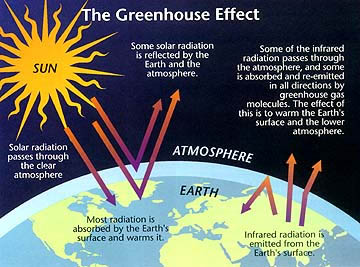Atmospheric Structure - Troposphere and Stratosphere
The global atmosphere extends 500 kilometers (310 miles) above the Earth’s surface from the lower troposphere to the upper exosphere (Figure 3). The atmosphere has evolved ever since the Earth was formed and along with the ocean is responsible for heat being distributed throughout the globe and thus is a principal driver of climate and weather. Climate and weather have much in common, but are not the same. Weather is an everyday experience representing the sum total of atmospheric variables in a particular region for a short duration. Climate is a long-term composite of day-to-day weather conditions and atmospheric variables in a region. The atmospheric variables that drive climate and weather are solar energy, humidity, precipitation, atmospheric pressure, and wind currents. It is very important that you clearly understand the difference between the two, so for a more detailed discussion, go to the NASA website (click here).
Figure 3. Atmosphere Structure. The red line is the atmospheric temperature in both Celsius (oC) and Fahrenheit (oF), which is measured on the x-axis. The y-axis is the altitude given in both miles (m) and kilometers (km).
The troposphere is the lowermost atmospheric region and it extends from the surface of the earth to about 12 kilometers above the surface. The tropospheric boundary layer is the lower 1 kilometer or so of the troposphere right above the Earth where mixing and frictional effects between the land and atmosphere are most dramatic. The troposphere is well-mixed due to the turbulence in this region caused by the radiant heating of the below earth's surface. In the lower troposphere, the air temperature is generally warmer near the surface and cooler above causing an unstable situation. The warmer, less dense (relatively light air compared to the colder denser air above) air rises and the cooler, more dense (relatively heavy compared to the warm air below) air wants falls towards the Earth's surface. Note in Figure 2 how the atmospheric temperature decreases from the earth surface to the troposphere/stratosphere boundary. In the troposphere, the weather system of clouds, surface winds, and water vapor circulates around the planet and is capped by the stratosphere.
The stratosphere extends from about 12 to 48 kilometers above the Earth. Ultraviolet radiation from the sun is absorbed and therefore blocked by ozone (O3) in the top two-thirds of the stratosphere between approximately 24 to 48 kilometers. This region is the ozone layer that protects life on the planet from UV radiation. The overproduction of ozone by natural processes is kept in check by the destruction of ozone by solar radiation and gases. The absorption of ultraviolet light by ozone is what warms the upper two-thirds of the stratosphere, which is why in Figure 3 the temperature increases from the lower stratosphere to the upper stratosphere. It is actually as warm or even warmer in the upper stratosphere due to ultraviolet radiation absorption than it is at Earth's surface! This warmer mid-to-upper stratosphere then effectively "caps" the cooler lower troposphere, which is one reason why we have a habitable climate at the earth's surface.

